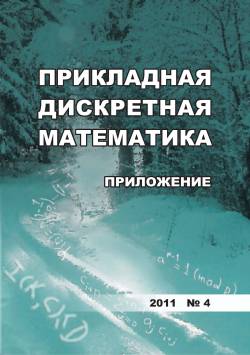Hall's polynomials for finite two-generator groups of exponent seven
Let = B 0(2, 7, k) be the largest two-generator finite group of exponent 7 and nilpotency class k. In this class, the largest group is the group B 28, which has the order 7 . For each , a power commutator presentation is obtained. Let aX ... an and a ... an be two arbitrary elements in the group recorded in the commutator form. Then their product is equal a^ ... an · a ... an = a^ ... an . Powers z are to be found based on the collection process which is implemented in the computer algebra systems GAP and MAGMA. Furthermore, there is an alternative method for calculating products of elements of the group, proposed by Ph. Hall. Hall showed that Z are polynomial functions (over the field Z 7 in this case) depending on the variables ж 1,..., ж г, y 1,..., у г, which are now called Hall's polynomials. Hall's polynomials are necessary in solving problems that require multiple products of the elements of the group. Studying the structure of the Cayley graph for a group is one of these problems. The computational experiments carried out on the computer in two-generator groups of exponent five showed that the method of Hall's polynomials has an advantage over the traditional collection process. Therefore, there is a reason to believe that the use of polynomials would be preferable than the collection process in the study of Cayley graphs for groups. It should be also noted that this method is easily software-implemented including multiprocessor computer systems. Previously unknown Hall's polynomials of are calculated within the framework of this paper. For k > 4, polynomials are calculated similarly but their output takes considerably more space so it makes impossible to verify the proof without use of computers.
Keywords
periodic group, collection process, Hall's polynomials, периодическая группа, собирательный процесс, полиномы ХоллаAuthors
| Name | Organization | |
| Kuznetsov A. A. | alex_kuznetsov80@mail.ru | |
| Safonov K. V. | safonovkv@rambler.ru |
References
